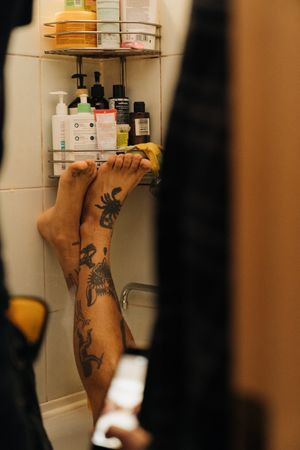So, you’ve just gotten some new ink and you’re probably wondering, “Can I Get A Fresh Tattoo Wet?” The short answer is yes, but with precautions. A new tattoo is essentially an open wound, and proper aftercare is crucial to prevent infection and ensure vibrant, long-lasting art. At tattooat.com, we’re dedicated to providing you with the best information and resources for tattoo care. From understanding the healing process to finding the perfect aftercare routine, we’ve got you covered. Let’s dive into the dos and don’ts of getting your new tattoo wet to maintain skin art integrity, avoid tattoo damage, and promote optimal skin recovery.
1. Understanding the First Few Hours: The Initial Tattoo Care
The first few hours after getting your tattoo are critical. During this period, your tattoo artist will likely apply a bandage or protective covering. This initial covering serves as a barrier against bacteria and environmental irritants.
1.1 Leaving the Bandage On
Typically, you should leave the bandage on for at least a few hours, or as instructed by your tattoo artist. According to recommendations, the duration can vary from 2 to 24 hours, depending on the type of bandage used.
1.2 What To Do After Removal?
After removing the bandage, gently wash the tattoo with mild, fragrance-free soap and lukewarm water. Pat it dry with a clean paper towel and allow it to air dry completely before applying a thin layer of tattoo-specific aftercare ointment.
 Fresh tattoo with bandage applied
Fresh tattoo with bandage applied
2. Showering With a New Tattoo: What You Need To Know
Showering with a new tattoo requires extra caution. While it’s essential to keep the area clean, prolonged exposure to water can hinder the healing process.
2.1 The First Shower: Timing and Precautions
You can shower after getting a tattoo, but wait at least 24 hours if you have a traditional bandage. If your tattoo artist used a waterproof bandage like Saniderm, you might be able to shower sooner, but always follow their specific instructions.
2.2 Step-by-Step Guide to Showering With a New Tattoo
- Keep it Brief: Limit your shower to 10-15 minutes to minimize water exposure.
- Lukewarm Water: Use lukewarm water to avoid irritating the skin.
- Avoid Direct Water Flow: Position yourself so that the tattoo isn’t directly under the shower stream.
- Gentle Cleansing: Use a mild, fragrance-free soap to gently cleanse the tattoo. Avoid scrubbing or using harsh chemicals.
- Pat Dry: After showering, gently pat the tattoo dry with a clean paper towel.
3. Types of Bandages: Saniderm vs. Traditional Wraps
The type of bandage used on your new tattoo significantly impacts how you care for it. Saniderm and traditional wraps have different properties and require different approaches.
3.1 Saniderm: The Waterproof Option
Saniderm is a breathable, waterproof bandage that protects the tattoo while allowing it to breathe. It can stay on for several days, reducing the need for frequent washing.
3.2 Traditional Wraps: Plastic Film or Gauze
Traditional wraps, such as plastic film or gauze, are not waterproof. They need to be removed within a few hours and require more frequent cleaning.
3.3 Key Differences and Care Instructions
| Feature | Saniderm | Traditional Wraps |
|---|---|---|
| Waterproof | Yes | No |
| Duration | Several days | Few hours |
| Cleaning | Less frequent | More frequent |
| Water Exposure | Protected | Requires careful avoidance |
4. Washing Your Tattoo: Best Practices
Properly washing your tattoo is crucial to prevent infection and promote healing.
4.1 Choosing the Right Soap
Opt for a mild, fragrance-free, and antibacterial soap. According to the American Academy of Dermatology, harsh soaps can irritate the skin and delay healing.
4.2 Step-by-Step Washing Instructions
- Wash your hands thoroughly before touching the tattoo.
- Wet the tattoo with lukewarm water.
- Gently apply the soap using your fingertips.
- Rinse thoroughly with lukewarm water.
- Pat dry with a clean paper towel.
4.3 Frequency of Washing
Wash your tattoo 2-3 times a day during the healing process.
5. The Importance of Keeping Your Tattoo Dry
While washing is essential, prolonged exposure to water can be detrimental. Keeping your tattoo dry is crucial for proper healing.
5.1 Risks of Overexposure to Water
- Infection: Excessive moisture can create a breeding ground for bacteria.
- Ink Leaching: Prolonged soaking can cause the ink to leach out, resulting in a faded tattoo.
- Delayed Healing: Water can soften the skin, making it more susceptible to damage and slowing down the healing process.
5.2 How To Keep Your Tattoo Dry
- Short Showers: Limit your shower time to minimize water exposure.
- Avoid Soaking: Avoid swimming, baths, and prolonged soaking in water.
- Proper Drying: Always pat your tattoo dry with a clean paper towel after washing or showering.
6. Swimming With a New Tattoo: A No-Go
Swimming is a definite no-go during the initial healing phase of a new tattoo.
6.1 Risks of Swimming Pools
Swimming pools contain chlorine and other chemicals that can irritate the skin and interfere with the healing process. Additionally, pools can harbor bacteria that can cause infection.
6.2 Risks of Natural Bodies of Water
Natural bodies of water, such as lakes, rivers, and oceans, can contain even more harmful bacteria and pollutants.
6.3 How Long To Wait Before Swimming
Wait at least 3-4 weeks, or until your tattoo is fully healed, before swimming.
 Woman in bathtub with tattoo out of water
Woman in bathtub with tattoo out of water
7. Bathing With a New Tattoo: What To Avoid
Bathing is another activity to avoid during the initial healing phase.
7.1 Why Baths Are Problematic
Soaking in a bathtub exposes your tattoo to prolonged moisture and potential contaminants.
7.2 Alternatives to Bathing
Opt for quick showers instead of baths until your tattoo is fully healed.
8. Dealing With a Wet Tattoo: Troubleshooting
Sometimes, despite your best efforts, your tattoo might get wet. Here’s how to handle it.
8.1 What To Do If Your Tattoo Gets Accidentally Wet
- Gently pat the area dry with a clean paper towel.
- Apply a thin layer of aftercare ointment.
- Monitor for any signs of infection, such as redness, swelling, or pus.
8.2 Signs of Infection
- Redness
- Swelling
- Pain
- Pus
- Fever
8.3 When To Seek Medical Attention
If you notice any signs of infection, seek medical attention immediately.
9. Aftercare Products: Choosing the Right Ointment
Choosing the right aftercare ointment is essential for promoting healing and preventing infection.
9.1 Recommended Ingredients
Look for ointments that contain ingredients such as:
- Petroleum Jelly: Provides a protective barrier.
- Vitamin E: Helps to moisturize and heal the skin.
- Aloe Vera: Soothes and reduces inflammation.
9.2 Products To Avoid
Avoid products that contain:
- Fragrances: Can irritate the skin.
- Alcohol: Can dry out the skin.
- Dyes: Can cause allergic reactions.
9.3 How To Apply Ointment
- Wash your hands thoroughly.
- Apply a thin layer of ointment to the tattoo.
- Gently rub it in until it’s absorbed.
- Apply ointment 2-3 times a day, or as needed.
10. The Healing Process: What To Expect
Understanding the healing process can help you properly care for your tattoo.
10.1 Stages of Healing
- Week 1: Redness, swelling, and oozing are common.
- Week 2: Itching and peeling may occur.
- Week 3: The tattoo may look fully healed, but the skin is still sensitive.
- Week 4: The tattoo should be fully healed.
10.2 Common Issues and Solutions
- Itching: Apply a thin layer of ointment and avoid scratching.
- Peeling: Let the skin peel naturally.
- Dryness: Apply ointment more frequently.
10.3 When To Consult a Tattoo Artist or Doctor
Consult a tattoo artist or doctor if you experience any signs of infection or have concerns about the healing process.
11. Long-Term Tattoo Care: Maintaining Your Art
Once your tattoo is fully healed, it’s essential to maintain it properly to keep it looking its best.
11.1 Sun Protection
Protect your tattoo from the sun by applying sunscreen with an SPF of 30 or higher. Sun exposure can cause the ink to fade over time.
11.2 Moisturizing
Keep your skin moisturized by applying lotion daily.
11.3 Avoiding Harsh Chemicals
Avoid using harsh chemicals or abrasive products on your tattoo.
 When You Can Take a Bath after a new tattoo
When You Can Take a Bath after a new tattoo
12. Debunking Common Tattoo Myths
There are many myths surrounding tattoo care. Let’s debunk some of the most common ones.
12.1 Myth: You Can’t Shower After Getting a Tattoo
Fact: You can shower after getting a tattoo, but you need to take precautions.
12.2 Myth: You Should Use Hot Water To Clean Your Tattoo
Fact: Hot water can irritate the skin. Use lukewarm water instead.
12.3 Myth: You Should Scrub Your Tattoo To Remove Excess Ink
Fact: Scrubbing can damage the skin. Gently cleanse the tattoo with your fingertips.
13. Tattoo Styles and Their Specific Needs
Different tattoo styles may require specific care.
13.1 Black and Grey Tattoos
Black and grey tattoos may be more prone to fading from sun exposure.
13.2 Color Tattoos
Color tattoos can be more sensitive to harsh chemicals and abrasive products.
13.3 Fine Line Tattoos
Fine line tattoos may require extra moisturizing to prevent the lines from blurring.
13.4 How To Adapt Your Aftercare Routine
Adapt your aftercare routine based on the specific needs of your tattoo style.
14. Traveling With a New Tattoo: Tips and Considerations
Traveling with a new tattoo requires extra planning and preparation.
14.1 Protecting Your Tattoo While Traveling
- Keep the tattoo covered with a bandage or protective clothing.
- Carry aftercare products with you.
- Avoid swimming pools and natural bodies of water.
14.2 Climate Considerations
- Hot Climates: Stay hydrated and apply sunscreen frequently.
- Cold Climates: Keep the skin moisturized to prevent dryness.
14.3 Airplane Travel
Airplane travel can dry out the skin. Apply ointment more frequently during your flight.
15. Tattoo Touch-Ups: When and Why
Touch-ups may be necessary to maintain the vibrancy and clarity of your tattoo.
15.1 Reasons for Touch-Ups
- Fading from sun exposure
- Ink fallout during the healing process
- Blurring of lines
15.2 When To Schedule a Touch-Up
Schedule a touch-up after your tattoo is fully healed, typically 4-6 weeks after the initial session.
15.3 Finding a Reputable Artist
Choose a reputable artist for your touch-up to ensure quality and safety.
16. Tattoos and Skin Conditions: What You Need To Know
If you have a skin condition, such as eczema or psoriasis, you need to take extra precautions when getting a tattoo.
16.1 Consulting a Dermatologist
Consult a dermatologist before getting a tattoo to discuss any potential risks.
16.2 Choosing a Tattoo Artist Experienced With Skin Conditions
Choose a tattoo artist who has experience working with clients who have skin conditions.
16.3 Adapting Your Aftercare Routine
Adapt your aftercare routine based on your specific skin condition.
17. Tattoos and Seasonal Changes: Adjusting Your Care
Seasonal changes can impact your tattoo and require adjustments to your care routine.
17.1 Summer Care
- Apply sunscreen frequently.
- Stay hydrated.
- Avoid prolonged sun exposure.
17.2 Winter Care
- Keep the skin moisturized to prevent dryness.
- Avoid hot showers and baths.
- Protect the tattoo from cold weather.
17.3 Spring and Fall Care
- Protect the tattoo from allergens.
- Keep the skin moisturized.
- Monitor for any signs of irritation.
18. Showcasing Tattoo Designs and Artists on Tattooat.com
Discover inspiration, connect with talented artists, and elevate your tattoo journey with tattooat.com.
18.1 Design Inspiration
Browse thousands of unique tattoo designs, from classic motifs to cutting-edge styles. Explore curated collections and personalized recommendations tailored to your taste.
18.2 Artist Spotlights
Discover talented tattoo artists near you or worldwide. View portfolios, read reviews, and connect with artists whose style resonates with you.
18.3 Booking Consultations
tattooat.com streamlines the consultation process, allowing you to easily book appointments with your chosen artist and discuss your vision.
19. Tattooat.com Community Features and Forums
Share your tattoo stories, connect with fellow enthusiasts, and gain valuable insights from experienced artists and collectors in tattooat.com’s vibrant community.
19.1 Sharing Your Tattoo Journey
Document your tattoo journey and inspire others by sharing photos, stories, and aftercare tips in our community forums.
19.2 Q&A With Tattoo Experts
Get your burning questions answered by experienced tattoo artists and aftercare specialists in our interactive Q&A sessions.
19.3 Participating in Discussions
Engage in lively discussions on a wide range of tattoo-related topics, from design trends to cultural significance, and connect with like-minded individuals.
20. Frequently Asked Questions (FAQs)
20.1 Can I use regular soap on my new tattoo?
No, use a mild, fragrance-free, and antibacterial soap.
20.2 How long should I wait before swimming?
Wait at least 3-4 weeks, or until your tattoo is fully healed.
20.3 Can I use lotion instead of ointment?
Ointment is recommended during the initial healing phase. Once the tattoo is fully healed, you can switch to lotion.
20.4 What if my tattoo gets infected?
Seek medical attention immediately.
20.5 How often should I apply ointment?
Apply ointment 2-3 times a day, or as needed.
20.6 Can I wear tight clothing over my new tattoo?
Avoid wearing tight clothing over your new tattoo to prevent irritation.
20.7 Is it normal for my tattoo to itch?
Yes, itching is common during the healing process. Avoid scratching.
20.8 How can I protect my tattoo from the sun?
Apply sunscreen with an SPF of 30 or higher.
20.9 What should I do if my tattoo is peeling?
Let the skin peel naturally. Avoid picking or pulling at it.
20.10 Can I exercise after getting a tattoo?
Avoid strenuous exercise during the initial healing phase to prevent irritation.
By following these guidelines, you can ensure that your new tattoo heals properly and remains a vibrant work of art for years to come. Remember, proper aftercare is key to preserving the beauty and longevity of your tattoo.
Finding the right tattoo design and artist is just the beginning of your tattoo journey. At tattooat.com, we are committed to helping you every step of the way, from inspiration to aftercare. Explore our extensive collection of designs, connect with talented artists, and access expert advice to make your tattoo experience unforgettable. Discover your next masterpiece at tattooat.com today! Visit us at 1825 SW Broadway, Portland, OR 97201, United States, or call us at +1 (503) 725-3000.